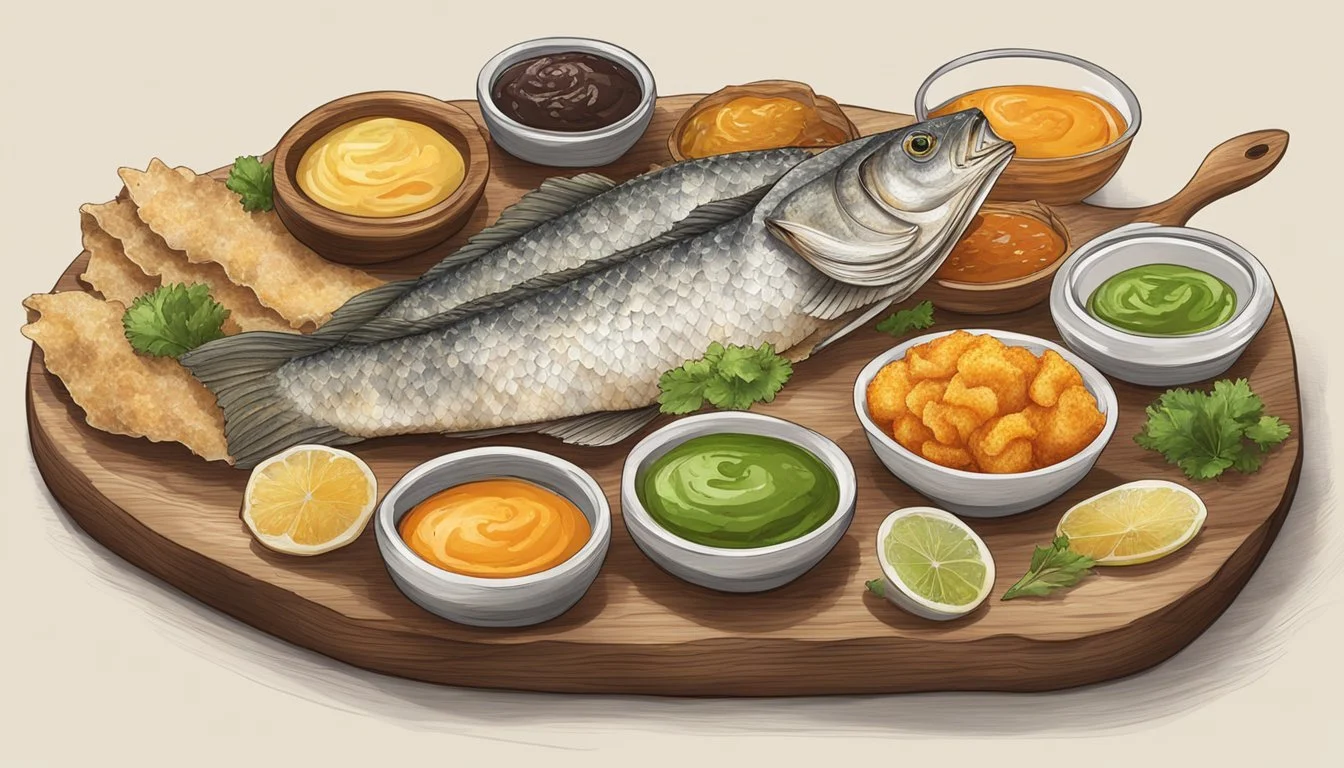Crispy Fried Fish Skin
Savory Snacks from Sustainable Seafood Practices
When looking for ways to minimize waste and maximize flavor in the kitchen, crispy fried fish skin is an ingenious solution. As seafood (What wine goes well with seafood?) lovers relish the delicate fillets of their favorite fish (What wine goes well with fish?), the skin is often discarded, despite its potential for transforming into a crispy, savory treat. The key lies in its preparation, where careful attention to drying and seasoning turns what might be considered scraps into a delectable snack or garnish.
Achieving the perfect crispy texture is a matter of technique. The fish skin must be thoroughly cleaned and scraped to remove any remaining flesh, which could prevent it from crisping up properly. It's then dried to eliminate moisture, a crucial step that ensures the skin will fry evenly. Once prepared, the skins are fried at a precise temperature until golden brown, resulting in a crunchy, satisfying bite that can rival any conventional snack.
Incorporating crispy fried fish skin into one's culinary repertoire not only reduces waste but also offers a unique addition to a variety of dishes. Whether enjoyed on its own or used as a topping for soups, salads, or main courses, crispy fish skin adds texture and flavor, transforming the ordinary into the extraordinary. Its utilization embodies a resourceful approach to cooking, where sustainability and gastronomy go hand in hand.
Nutritional Benefits of Fish Skin
Fish skin, often discarded as a byproduct of seafood preparation, is a hidden gem in terms of nutrition. It boasts not only a rich concentration of omega-3 fatty acids but is also a source of protein and collagen, conferring numerous health benefits.
Omega-3 Fatty Acids Content
The fish skin, particularly from species like salmon, (What wine goes well with salmon?) bass, trout, and cod, contains a notable amount of omega-3 fatty acids. These polyunsaturated fats play a crucial role in cardiovascular health and cellular repair. They are also instrumental in reducing inflammation.
Salmon skin: High in omega-3 content, beneficial for heart health.
Bass and trout skin: Contains omega-3 fatty acids that aid in brain function.
Cod skin: Offers a fair amount of omega-3s.
Protein and Collagen
Fish skin is more than just an omega-3 powerhouse; it is also a valuable source of protein and collagen. Protein is essential for muscle repair and growth, while collagen promotes skin elasticity, which may translate to benefits for human skin health.
Protein: Essential for bodily repair and enzymatic processes.
Collagen: Promotes skin health and may improve skin elasticity.
Integrating fish skins into one's diet can contribute positively to nutritional intake, tapping into the benefits that are often overlooked in seafood scraps.
Selecting the Right Fish for Crispy Skin
Creating the perfect crispy fish skin starts with selecting the appropriate type of fish. The ideal candidates are those with firm flesh and non-oily skin that crisps well when cooked.
Types of Fish Suitable for Crispy Skin
Salmon: Known for its robust flavor and firm texture, salmon's skin crisps beautifully if cooked correctly.
Cod: Cod has a mild flavor and firm body, making it a popular choice for achieving a crispy skin.
Bass: Both sea bass and black bass have a suitable skin for crisping and are celebrated for their delicate flavor.
Snapper: With its firm texture, snapper skin can attain a desirable crispness, providing a satisfying contrast to its flaky meat.
Tilapia: A versatile fish with firm flesh, tilapia's skin can become nicely crispy when prepared with care.
Trout: Freshwater trout offers thinner fillets that can quickly achieve a crispy skin under high heat.
Freshness and Quality Indicators
Firmness: The fish's flesh should be firm to the touch, as this indicates freshness and helps the skin crisp effectively.
Appearance: Look for bright, clear eyes and shiny skin, which are signs of a freshly caught fish.
Skin Side Up: When storing, always keep the fish skin side up to preserve skin integrity, crucial for achieving crispiness when cooked.
Preparation Techniques
The perfect crispy fish skin requires meticulous preparation. Two key steps in this process are thorough cleaning and drying of the skin as well as employing proper skinning methods for the best results.
Cleaning and Drying for Optimal Crispiness
Proper cleaning and drying are essential for achieving the desired crispiness of fish skin. Fish, especially salmon, contain moisture that can inhibit crisping. One should start by using a sharp knife to scale and gut the fish, ensuring all scales are removed. Next, the skin must be patted down with paper towels to remove as much moisture as possible. A neglected but crucial step is to leave the fish, skin-side up, uncovered in the refrigerator for about an hour to allow the skin to dry out thoroughly before frying.
Cleaning steps include:
Scale and gut the fish carefully.
Remove all excess moisture with paper towels.
Tips for Skinning Fish
Obtaining a clean and intact piece of skin is an art that requires a deft touch and the right technique. The individual begins by making shallow, diagonal cuts into the fish skin, which aids in rendering fat and creating a crispy texture upon cooking. Utilizing a sharp knife not only makes the job smoother but also helps in maintaining the integrity of the skin. Once the fish has been scaled and dried, it is often recommended to season the skin lightly with salt and pepper just before cooking, enhancing the flavor profile and aiding in the crisping process.
Skinning Techniques:
Score the skin using a sharp knife, and be gentle to keep it intact.
Season the skin with salt and pepper just before cooking to promote a crispy texture.
Seasoning and Marinating Choices
Choosing the right seasoning and marinating techniques can elevate the simple fish skin to an impressive and flavorful snack.
Salt and Pepper Basics
To achieve perfectly seasoned crispy fish skin, one must start with the fundamental duo: salt and pepper. Kosher salt is preferred by chefs for its pure taste and the control it affords in seasoning. Black pepper should be freshly ground to maximize its vivid aroma and slightly hot flavor profile. Here are the basic steps:
Dry the fish skin thoroughly
Sprinkle evenly with kosher salt and black pepper
Creative Seasonings and Marinades
Expanding beyond the basics, seafood enthusiasts have a plethora of seasonings to choose from. A combination of sea salt, garlic, and paprika can add complexity, while a touch of cayenne pepper infuses a gentle heat. For marinating, consider these ingredients:
Sea salt - Enhances natural flavors
Garlic (minced or powder) - Adds depth
Paprika - Provides a sweet, smoky element
Cayenne pepper - Introduces a spicy kick
For an effective marinade:
Combine all seasonings in a small bowl
Brush the fish skin with the mixture
Let rest for 10-15 minutes before cooking
These seasonings and marinades will not only impart mouth-watering flavors but also contribute to achieving the desired crispy texture.
Cooking Methods for Crispiness
To achieve the desired crispiness in fish skin, the cooking method and proper heat application are crucial. One can opt for pan-frying to utilize direct, consistent heat or oven methods for even crisping and cooking through.
Pan-Frying for Maximum Crunch
Pan-frying fish skin necessitates a nonstick skillet or a well-seasoned cast iron pan to ensure the skin does not stick. The pan should be heated over high heat before adding a thin layer of oil—vegetable oil, grapeseed oil, or avocado oil work well due to their high smoke points. Once the oil is shimmering but not smoking, lay the fish skin side down. It's important not to overcrowd the pan, as this can reduce the pan’s temperature and prevent crispiness. Press down on the fish gently to ensure even contact with the pan, and cook until the flesh is opaque with a crispy, golden-brown skin.
Steps for Pan-Frying Fish Skin:
Preheat the pan on high heat.
Add a thin coat of high smoke point oil.
Place fish skin side down in the pan.
Press gently to ensure even contact.
Cook until the skin is crispy and flesh is opaque.
Oven Baking and Broiling
For those preferring to use an oven, start by preheating it to a high temperature. This method can be beneficial for thicker cuts of fish that might not cook through on the stovetop. Place the fish skin side up on a baking sheet, ideally lined with foil or parchment for easy cleanup. If baking, keep the fish in the middle of the oven to cook through steadily. For broiling, which applies intense heat from above, place the fish closer to the broiler element for a shorter amount of time. Pay close attention to avoid burning the skin.
Tips for Oven Baking and Broiling Fish Skin:
For baking, preheat the oven and use high heat for even cooking.
For broiling, monitor closely to prevent burning the skin.
Either method should be done with the fish skin side up for optimal crispiness.
Mastering the Art of Frying Fish Skin
To achieve perfectly crispy fish skin, attention to detail in preparation and cooking technique is essential. This section explains how to avoid pitfalls and create fish skin with a golden and crispy texture.
Avoiding Common Mistakes
Sticking: Ensure the skin of the fish is thoroughly dried, as moisture is the main culprit for sticking. Using paper towels, pat the skin until it's completely dry.
Ripping: When placing fish skin in the pan, do so gently to prevent any tearing. The use of a flat spatula can assist in carefully managing the skin.
Curling: Fish skin tends to curl due to uneven heat distribution. To combat this, press down gently on the fish skin with a spatula for 15 seconds after placing it in the pan.
Moving the Fish Prematurely: Once the fish skin is in the pan, resist the urge to move it. Let it sear undisturbed to allow the crisp layer to form fully.
Achieving the Perfect Texture
Heat Control: Medium-high heat is ideal for creating crispy skin. Too high, and the skin burns before it crisps; too low, and it'll be soggy.
Timing: Depending on the thickness, 3-4 minutes per side should suffice. Cook until the skin turns golden and releases itself from the pan.
Pan Choice: Use a non-stick frying pan or well-seasoned cast iron skillet to minimize the risk of the skin sticking.
Oil Temperature: Ensure the oil is shimmering but not smoking. This indicates that the pan is hot enough for the skin to start crisping immediately upon contact.
By adhering to these detailed instructions, one can master the art of frying fish skin, transforming what could be waste into a deliciously crispy treat.
Sauces and Accompaniments
The right sauce or side dish can elevate crispy fish skin from a simple snack to a culinary delight. Here you'll find targeted advice on selecting the perfect sauces and ideal side dishes to complement the crisp texture and rich flavor of the fish skin.
Selecting Sauces for Crispy Fish Skin
When it comes to crispy fish skin, both the texture and the flavor need to be complemented correctly. Lemon butter sauce is a celebrated choice that brings a rich and tangy balance to the crispiness of the fish skin. A lemon cream sauce can similarly blend creamy texture with citrusy brightness, perfect for adding a luxurious touch to each bite. For those who desire a bit of zest, a simple cocktail sauce enriched with lemon juice provides a delightful kick.
For dipping sauces, consider varying levels of acidity and spice. Here is a table outlining suitable sauce options:
Sauce Type Key Ingredients Flavor Profile Lemon Butter Butter, Lemon Juice Rich, Citrusy Lemon Cream Cream, Lemon Zest, Garlic Smooth, Tart Cocktail Sauce Ketchup, Horseradish, Lemon Tangy, Spicy
Each sauce can be garnished with parsley or lemon wedges to enhance their flavor and add a visual appeal to the presentation.
Side Dishes to Complement the Skin
The side dishes chosen to accompany crispy fish skin should underscore its texture without overpowering it. Simple, lightly dressed greens or a crisp slaw can offer a refreshing contrast to the rich, crunchy skin. One could also opt for a rustic potato salad, subtly seasoned to allow the fish skin to be the star of the show. Side dishes may also include a squeeze of lemon juice or a lemon wedge on the side to allow guests to adjust the zesty flavor to their liking.
Serving and Presentation Tips
When serving crispy fish skin, one's attention to detail transforms this simple dish into an elegant appetizer or side. Ensuring that the presentation complements the delicate crispness of the fish skin enhances the overall dining experience.
Proper Plating Techniques
For an appetizer, chefs often arrange crispy fish skin on a plate in a way that showcases its texture. They might stack the skins slightly overlapping each other or arrange them in a fan shape for visual appeal.
Garnishes: A light sprinkle of sea salt and a side of citrus aioli can accentuate the skin's flavor. Fresh herbs add color and provide a fresh contrast to the rich, savory taste of the skin.
Use of colorful plates or those with a contrasting texture can make the crispy fish skin stand out, making it a feast for the eyes as well as the palate.
Using Fish Skin in Other Dishes
Crispy fish skin is versatile and can be used to add texture and flavor to a variety of dishes. As a topping, it adds a satisfying crunch to salads or soups and can be seen resting atop these dishes just before serving.
Salads: Break the fish skin into shards and sprinkle them over greens to add a crunchy element.
Soups: Float smaller pieces on top of a creamy chowder or a clear broth to elevate the dish with an unexpected texture.
Chefs may present crispy fish skin as a side dish, accompanying it with complementary flavors that can stand up to its distinctive taste. The key is to serve it immediately after cooking to maintain its crispness, offering diners an optimal textural experience.
Storage and Reheating for Best Results
The delicate crunch of crispy fried fish skin is best preserved by proper storage and careful reheating. Here are optimal strategies to maintain that prized crispiness for later enjoyment.
Keeping Fish Skin Crispy for Later
To ensure fried fish skin remains crisp, storage is key. Once the fish skin has cooled to room temperature, it should be transferred onto a plate and covered loosely with paper towels. This allows any excess oil to be absorbed and prevents moisture from softening the fish skin. For best results, store the fish skin in an airtight container in the fridge. It is crucial to allow it to cool completely before sealing to prevent condensation from forming, which can lead to soggy skin.
Let fish skin cool.
Transfer to a plate and cover with paper towels.
Place in an airtight container.
Refrigerate.
Reheating Without Losing Texture
When it comes time to reheat the fish skin, one must take care to preserve its crispiness. The best method is to use an oven or toaster oven. Preheat the oven to 350 degrees Fahrenheit and place the fish skin on a wire rack set over a baking sheet. This setup allows air to circulate around the fish skin, reheating it evenly without making it chewy.
Preheat oven to 350°F.
Place fish skin on a wire rack over a baking sheet.
Heat for 4 to 10 minutes, depending on thickness.
Check periodically and remove once it is sufficiently warm and crispy.
For a quick reheat, one can also use a skillet on medium-high heat. Add a small amount of oil and place the fish skin in the skillet. Let it heat up for approximately 1 to 2 minutes on each side until it regains its crispiness. It's important to let the fish skin rest for a minute after reheating to ensure the texture stabilizes.
Skillet reheating steps:
Heat skillet on medium-high.
Add a touch of oil.
Place fish skin in skillet for 1 to 2 minutes per side.
Allow to rest for a minute before serving.
Health and Dietary Considerations
When considering the health and dietary implications of crispy fried fish skin, one should be mindful of its calorie and fat content. It is also beneficial to note that fish skin can be a gluten-free option for those with specific dietary needs and can be prepared in an allergy-friendly manner.
Calories and Fat Content
Crispy fried fish skin is a snack rich in both calories and fats. The caloric content typically varies depending on the cooking method and the size of the serving. A general breakdown is as follows:
Small serving (10g): Approximately 58 calories and 4g of fat
Medium serving (20g): Approximately 116 calories and 8g of fat
Large serving (30g): Approximately 174 calories and 12g of fat
The fat content is significant and includes omega-3 fatty acids, which are beneficial to cardiovascular health and may assist with anti-inflammatory effects. Consumers should consume crispy fish skin in moderation, particularly in the context of an overall balanced diet.
Gluten-Free and Allergy-Friendly Options
Fish skin, by nature, is a gluten-free food, making it a suitable snack option for individuals with gluten sensitivities or celiac disease. When preparing crispy fried fish skin, one should ensure that the other ingredients used, such as batter or seasoning, are also gluten-free to avoid cross-contamination.
Moreover, for those with specific allergies, it is important to choose spices and cooking oils that do not contain allergens. Fish skin can be seasoned with a variety of spices such as:
Sea salt
Black pepper
Paprika
For the frying process, oils that are less likely to cause allergic reactions, such as olive oil, can be used. It is always essential to check the ingredient labels and verify that the kitchen equipment is free from allergen residues to keep the dish allergy-friendly.
Innovative Recipes and Variations
When cooking with fish skin, chefs are creating an array of dishes that reinvent classic recipes and draw on global influences. These innovative uses of fish skin not only add a unique texture but also elevate the dish to a gourmet level.
Classic Recipes Reinvented
In the quest for that perfect crispiness, many chefs recommend a sequence of drying, heat control, and proper skin preparation. A classic technique involves patting the fish skin dry, scoring it, and coating it lightly with flour before deep frying. This can be integrated into traditional recipes like fish and chips (What wine goes well with fish and chips?), bringing a delightful crunch to every bite.
Ingredients:
Fish skin
Flour for coating
Method:
Pat the fish skin dry and score it lightly.
Coat with a thin layer of flour.
Deep fry in hot oil until golden and crispy.
Moreover, chefs are reimagining fish skin as a standalone snack, akin to pork rinds. Recipes often call for seasoning the skins post-fry with a blend of spices, transforming them into a savory treat.
Global Inspirations for Fish Skin Dishes
The versatility of fish skin shines through in dishes inspired by global cuisines. Chinese recipes, for example, make masterful use of fish skin in dim sum. Fish skin can be cut into strips, seasoned with soy sauce, spices, and then stir-fried until they reach the desired crispness.
Ingredients:
Fish skin strips
Soy sauce
Preferred spices (e.g. Five-spice powder)
Method:
Marinate fish skin strips in soy sauce and spices.
Stir-fry until crispy.
Another recipe, inspired by Southeast Asian flavors, incorporates fish skin into salads by topping the greens with shards of crispy skin, adding a delightful texture and an umami punch. The key is to balance the bold crunch of fish skin with the freshness of herbs and the tang of dressings used in regional specialties.
Engaging with the Community
Crispy fried fish skin recipes have the potential to turn seafood scraps into culinary trends. Engaging with the community is essential to spread the word and inspire others to try this sustainable and delicious option. Social media platforms offer powerful tools to share content, while responding to feedback encourages a loyal following that can lead to wider adoption of these cooking practices.
Sharing on Social Media
Chefs and food enthusiasts can utilize platforms like Instagram, Facebook, and Pinterest to showcase the versatility of crispy fried fish skin. Posting appealing photos and videos of the cooking process and final dishes can captivate an audience. Here are effective strategies to maximize outreach:
Instagram: Use high-quality images and relevant hashtags to reach a broader audience. Regular posts and stories invite followers to see the making of crispy fish skin, while IGTV provides a platform for longer cooking tutorials.
Pinterest: Pin step-by-step recipe guides and infographics to attract users interested in unique cooking tips and sustainable eating.
Facebook: Create a page dedicated to seafood sustainability and share posts that include recipes, cooking tips, and live cooking sessions to engage with users.
Receiving and Responding to Feedback
It is important to maintain a responsive presence by replying to comments and messages. Engagement can encourage users to subscribe and share content, leading to an interactive community. Here's a simple structure to manage feedback:
Approachability: Acknowledge every piece of feedback, showing the community that their opinions are valued.
Constructiveness: Address negative comments constructively; offer solutions and maintain a professional demeanor.
Encouragement: Motivate users to try recipes themselves and share their own experiences with crispy fish skin.
By integrating these practices into community engagement strategies, individuals and organizations can build a sustainable and participatory food culture centered around innovative seafood recipes.









